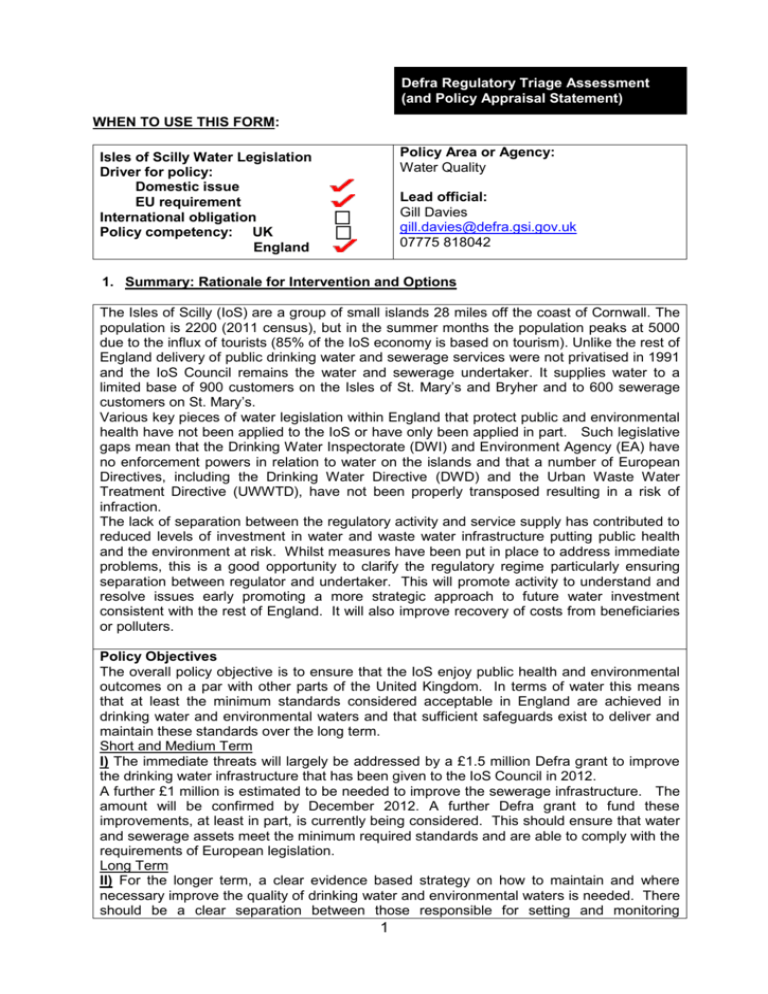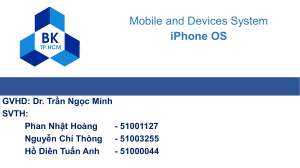Impact Assessment - Defra Consultation Hub
advertisement

Defra Regulatory Triage Assessment (and Policy Appraisal Statement) WHEN TO USE THIS FORM: Isles of Scilly Water Legislation Driver for policy: Domestic issue EU requirement International obligation Policy competency: UK England Policy Area or Agency: Water Quality Lead official: Gill Davies gill.davies@defra.gsi.gov.uk 07775 818042 1. Summary: Rationale for Intervention and Options The Isles of Scilly (IoS) are a group of small islands 28 miles off the coast of Cornwall. The population is 2200 (2011 census), but in the summer months the population peaks at 5000 due to the influx of tourists (85% of the IoS economy is based on tourism). Unlike the rest of England delivery of public drinking water and sewerage services were not privatised in 1991 and the IoS Council remains the water and sewerage undertaker. It supplies water to a limited base of 900 customers on the Isles of St. Mary’s and Bryher and to 600 sewerage customers on St. Mary’s. Various key pieces of water legislation within England that protect public and environmental health have not been applied to the IoS or have only been applied in part. Such legislative gaps mean that the Drinking Water Inspectorate (DWI) and Environment Agency (EA) have no enforcement powers in relation to water on the islands and that a number of European Directives, including the Drinking Water Directive (DWD) and the Urban Waste Water Treatment Directive (UWWTD), have not been properly transposed resulting in a risk of infraction. The lack of separation between the regulatory activity and service supply has contributed to reduced levels of investment in water and waste water infrastructure putting public health and the environment at risk. Whilst measures have been put in place to address immediate problems, this is a good opportunity to clarify the regulatory regime particularly ensuring separation between regulator and undertaker. This will promote activity to understand and resolve issues early promoting a more strategic approach to future water investment consistent with the rest of England. It will also improve recovery of costs from beneficiaries or polluters. Policy Objectives The overall policy objective is to ensure that the IoS enjoy public health and environmental outcomes on a par with other parts of the United Kingdom. In terms of water this means that at least the minimum standards considered acceptable in England are achieved in drinking water and environmental waters and that sufficient safeguards exist to deliver and maintain these standards over the long term. Short and Medium Term I) The immediate threats will largely be addressed by a £1.5 million Defra grant to improve the drinking water infrastructure that has been given to the IoS Council in 2012. A further £1 million is estimated to be needed to improve the sewerage infrastructure. The amount will be confirmed by December 2012. A further Defra grant to fund these improvements, at least in part, is currently being considered. This should ensure that water and sewerage assets meet the minimum required standards and are able to comply with the requirements of European legislation. Long Term II) For the longer term, a clear evidence based strategy on how to maintain and where necessary improve the quality of drinking water and environmental waters is needed. There should be a clear separation between those responsible for setting and monitoring 1 standards and those responsible for delivering an investment strategy for water and waste water infrastructure. Behavioural Issues III) The IoS Council will be encouraged to become self sufficient and less reliant on government funding to support its drinking water and sewerage asset replacement by working in partnership with the DWI and EA. A more strategic and transparent plan should allow the council to engage with its customers on key issues and challenges faced. This should allow a more open debate on how to maintain assets and plan for future funding. 2. Potential Policy Options i) Do Nothing The main advantages to leaving the legislation unchanged are to eliminate the resource requirements to bring them into effect and would avoid potential controversy around first time environmental permitting burdens for the IoS Council, the Duchy of Cornwall, Tresco Estates and those residents with discharges. Residents are likely to question the payment of charges (however small) as hitherto water discharge and other activities have been free of charge. However, the management of the public health and environmental risks would remain on an informal footing with the regulators (DWI and EA) which may not be sustainable in the long term. There would remain a lack of clear transparent drivers for improvements when they are necessary. This may lead to risks not being identified and addressed early and a build up of investment requirements which would need to be addressed by further significant capital injections from central government. The infraction risk would also not be addressed and there could be issues of preferential treatment compared to those who are already permitted on the mainland. ii) Non-Regulatory Options The non regulatory options are similar to the do nothing option described above as the DWI has operated informally on the IoS since 2006. More recently the EA has an involvement in groundwater and coastal water protection. In order to assist the maintenance of the quality of the public (and private) drinking water supplies their position as regulators needs to continue and be enhanced to provide confidence in the quality of water supplies. The EA and DWI do not have legal powers of enforcement. This could limit their ability to act to protect human health or the environment or to provide the IoS with the level of support necessary were their resources required to fulfil legal obligations elsewhere. The current non-regulatory framework does not allow the DWI and EA to recover costs against their activities. Many European directives, notably UWWTD, DWD and Water Framework Directive (WFD) are not fully applied to the IoS either directly in their transposition or through their reliance on powers and obligations found in domestic legislation. This results in a risk of infraction. iii) Regulatory Options The application of legislation will drive better behaviour and improve standards through the service providers being held to account within the regulatory framework. This approach has worked well on the mainland. Applying all the appropriate legislation in the IoS that does not currently apply would ensure the regulators are able to operate on a firm legal basis to protect human health and the environment. It will also allow them to recover costs against their regulatory activities. This should allow them to achieve public health and environmental protection outcomes that are equivalent to those for the mainland. It would limit the regulatory burdens associated with a blanket approach to applying legislation that is not relevant to the IoS. It would avoid the risk of infraction for incomplete application of relevant European Directives. This would mean that the IoS Order will fill all the necessary gaps and there would be no need for a further 2 Order in a few years if the environment or drinking water supply should deteriorate as a result of partial enactment of legislation. The risk of any future requirement for further public money to support asset replacement will be reduced by the development of a strategic plan that avoids the assets needing replacement all at once. This should allow the costs of asset replacement to be met by the IoS Council. Would these options result in additional costs to business? Yes No Could such costs exceed £1m per year? Yes No iv) Options that have been ruled out An option to apply some but not all legislation (such as applying all European legislation but not domestic legislation) was considered. This was ruled out on the basis that domestic legislation is needed to fully transpose and implement some European Directives, which would therefore be technically challenging and confusing. All drinking water and environmental legislation as applied in England could be applied to the IoS by taking a blanket approach. The main disadvantage would be, as some of the legislation appropriate to the mainland would not be relevant to the IoS, a plethora of irrelevant legislation may be introduced to the statute books. This would be the converse of the Better Regulation Agenda. 3. Initial data to be transferred to the Regulatory Management Tool Link: Regulatory Management Tool (RMT) Unique policy identification number An Impact Assessment will be required A formal consultation will be required For legislative options - The type of legislation will be For legislative options - The impact on existing statute will be For legislative options - This measure consists of several elements so that it meets our minimum EU requirements on a number of European Water related Directives, but it does not go beyond these requirements (i.e it is not gold plated). Implementing European legislation is out of scope of OIOO. Implementing domestic legislation is an ‘IN’ with an equivalent annual net cost to business of £0.0021m. For legislative options - The following will be required Fast track Policy clearance is available Target date for call for evidence consultation Target date for call for consultation on proposals Target date for Implementation [or to finalise policy options/IA?] Estimated FTEs required to develop policy through to clearance DEFRA1224 Yes No Yes No Primary Secondary Affirmative Negative New Amending Deregulatory Repealing Out of scope An Out An In £1mAn In £1m+ A sunset A review clause Yes No October 2013 (SNR6) 1 4. Policy Sign-On We have considered the problem and desired outcomes and have agreed the options and evidence required to enable those options to be further assessed and compared Sign-on team Name Date Policy Lead Gill Davies Better Regulation Andy Welberry Economist Nick Haigh 3 Lawyer Social Researcher Delivery Body [Other] Approval to proceed (SRO) (After agreement to any business case produced) N/A N/A DWI and EA John Bourne 5. Summary of Existing Evidence / Evaluation For Policy Appraisal complete Annex A Fast Track measures complete Annex B (To be submitted to RPC for validation) 4 ANNEX B – Rationale for Fast Track measures Rationale for intervention and intended effects The Isles of Scilly (IoS) are a group of small islands 28 miles off the coast of Cornwall. The population is 2200 (2011 census), but in the summer months the population peaks at 5000 due to the influx of tourists (85% of the IoS economy is based on tourism). Unlike the rest of England delivery of public drinking water and sewerage services were not privatised in 1991 and the IoS Council remains the water and sewerage undertaker. It supplies water to a limited base of 900 customers on the Isles of St. Mary’s and Bryher and to 600 sewerage customers on St. Mary’s. Various key pieces of water legislation within England that protect public and environmental health have not been applied to the IoS or have only been applied in part. Such legislative gaps mean that the Drinking Water Inspectorate (DWI) and Environment Agency (EA) have no enforcement powers in relation to water on the islands and that a number of European Directives, including the Drinking Water Directive (DWD) and the Urban Waste Water Treatment Directive (UWWTD), have not been properly transposed resulting in a risk of infraction. The lack of separation between the regulatory activity and service supply has contributed to reduced levels of investment in water and waste water infrastructure putting public health and the environment at risk. Whilst measures have been put in place to address immediate problems, a clear separation between the regulator and regulated would allow the distance to understand risks, set objectives and develop a clear strategic approach to future water investment consistent with the rest of England. One example of the threats faced is the risk to groundwater drinking water supplies, which are particularly vulnerable to over-abstraction with the potential for saline ingress contaminating supplies. The immediate threats will largely be addressed by a £1.5 million Defra grant to improve the drinking water infrastructure that has been given to the IoS Council in 2012. A further £1 million is estimated to be needed to improve the sewerage infrastructure. The amount will be confirmed by December 2012. A further Defra grant to fund these improvements, at least in part, is currently being considered. This should ensure that water and sewerage assets meet the minimum required standards and are able to comply with the requirements of European legislation. For the longer term, a clear evidence based strategy on how to maintain and where necessary improve the quality of drinking water and environmental waters is needed. There should be a clear separation between those responsible for setting and monitoring standards and those responsible for delivering an investment strategy for water and waste water infrastructure. The IoS Council will be encouraged to become self sufficient and less reliant on government funding to support its drinking water and sewerage asset replacement by working in partnership with the DWI and EA. A more strategic and transparent plan should allow the Council to engage with its stakeholders on key issues and challenges faced. This should allow a more open debate on how to maintain assets and plan for future funding. However, even with the capital expenditure and longer term asset replacement being addressed risks to the long term sustainability of the groundwater drinking supply exist that will need to be addressed through a regulatory framework. Policy objectives and intended effects The overall policy objective is to ensure that the IoS enjoy public health and environmental outcomes on a par with other parts of the United Kingdom. In terms of water this means that at least the minimum standards considered acceptable in England are achieved in drinking water and environmental waters and that sufficient safeguards exist to deliver and maintain these standards over the long term. Viable policy options (including alternatives to regulation) Option 1 - Full application of legislation as applied in England 5 All drinking water and environmental legislation as applied in England could be applied to the IoS by taking this blanket approach. The main advantage to doing this would be consistent regulation for drinking water and the environment on the IoS compared with England, and no gaps in legislation going forward. The main disadvantage would be, as some of the legislation appropriate to the mainland would not be relevant to the IoS, a plethora of irrelevant legislation may be introduced to the statute books. This would be the converse of the Better Regulation Agenda. There are examples of this on the drinking water and environmental side. For instance, the Water Industry Act competition provisions for water companies, such as financial regulation by OFWAT, Consumer Council for Water representation etc. cannot be applied to the IoS Council as water undertaker. On the environmental side there are no rivers therefore the Freshwater Fish Directive does not apply. Similarly, there has been no historic mining activity therefore legislation to control abandoned mines will not apply. Finally, there may be unintended consequences in applying such legislation that could lead to an unnecessary administrative burden. Option 2 – Application of all appropriate legislation The application of legislation will drive better behaviour and improve standards through the service providers being held to account within the regulatory framework. This approach has worked well on the mainland. Applying all the appropriate legislation in the IoS that does not currently apply would ensure the regulators are able to operate on a firm legal basis to protect human health and the environment (Annex 1). It will also allow them to recover costs against their regulatory activities. This should allow them to achieve public health and environmental protection outcomes that are equivalent to those for the mainland. It would limit the regulatory burdens associated with a blanket approach to applying legislation that is not relevant to the IoS. It would avoid the risk of infraction for incomplete application of relevant European Directives. This would mean that the IoS Order will fill all the necessary gaps and there would be no need for a further Order in a few years if the environment or drinking water supply should deteriorate as a result of partial enactment of legislation. The risk of any future requirement for further public money to support asset replacement will be reduced by the development of a strategic plan that avoids the assets needing replacement all at once. This should allow the costs of asset replacement to be met by the IoS Council. Other non regulatory approaches have been considered The non regulatory options are similar to the do nothing option as the DWI has operated informally on the IoS since 2006. More recently the EA have an involvement in groundwater and overall environmental water protection. In order to assist the maintenance of the quality of the public (and private) drinking water supplies their position as regulators needs to continue and be enhanced to provide confidence in the quality of water supplies. The EA and DWI do not have legal powers of enforcement. This could limit their ability to act to protect human health or the environment or to provide the IoS with the level of support necessary were their resources required to fulfil legal obligations elsewhere. The current non-regulatory framework does not allow the DWI and EA to recover costs against their activities. Many European directives, notably UWWTD, DWD and Water Framework Directive (WFD) are not fully applied to the IoS either directly in their transposition or through their reliance on powers and obligations found in domestic legislation. This results in a risk of infraction. There would remain a lack of clear transparent drivers for asset improvements when they are necessary. This may lead to risks not being identified and addressed early and a build up of investment requirements which would need to be addressed by further significant capital injections from central government. Option 2 is the preferred option. 6 Initial assessment of business impact Option 1 The monetised costs and non-monetised benefits will be the same as described for Option 2 below. However, in applying irrelevant legislation under this Option it could lead to an unnecessary administrative burden which could increase costs (this has not been monetised). Option 2 Monetised Costs Business and Micro-businesses Businesses will be the land owners and managers, the Duchy of Cornwall and Tresco Estates, around the size of an SME. The privately owned hotels, campsites and B&Bs fall into the category of micro-businesses. From the Table in Annex 1, an assessment of introducing the Environmental Permitting Regulations (EPR) 2010 on the Duchy and Tresco Estates and on micro-businesses currently would result in an estimated cost of £6.4k for the first year and then annual subsistence charges each year (£2k). This is based on one large sewage discharge from the Tresco Estates (£884 plus £2000 annually) that attracts the bulk of the permit charges. The three private sewage plant discharges (micro-businesses) would bring in first year charges of £125 and then will be exempt. Similarly an estimated 25 septic tank discharges out of 250 on the islands (that are domestic discharges close to drinking water supplies) would qualify for £125 first time charges and then be exempt. These estimates will be improved through a survey to be conducted by the EA from October ‘12 and through the consultation process. We have based the current estimates on the results of a Water Interests survey in August 2011, where the number and nature of small sewage treatment plants and septic tanks discharging to soak-away on the islands were approximated. It may increase marginally from £6.4k in the first year and £2k in subsequent years as our understanding of the size of the discharges and their proximity to drinking water boreholes improves. The business NPV over 25 years is £-0.04m. The equivalent annual net cost to business (in 2009 prices) is £0.0021m. IoS Council The largest cost impact from legislating is the capital expenditure required to improve the drinking water and sewerage infrastructure, which falls to the IoS Council as it is the public water and sewerage undertaker. A Defra grant of £1.5 million has already been paid to the IoS Council for drinking water improvements identified by the DWI, so can be considered as a sunk cost. The latest estimate is that £1m is required from a Defra grant in order to improve the sewerage system, and is being applied for in the final quarter of ‘12/’13. All the new assets have a life span of at least 25 years, which is considered to be a conservative estimate as many assets could last longer. On the environmental side, the regulatory costs would be for first time permits under the EPR, with an ongoing annual subsistence charge. The IoS Council as the public sewerage undertaker has 2 discharges which would result in an initial application fee of £8.2k and annual charge of £6.5k (based on volume). 7 Other licensing costs for the IoS Council will be from abstraction charges for the 5 public supply boreholes that exceed the 20 cubic metres per day licensing threshold (£10k in the first year). The licence lasts for 12 years and on renewal will cost an estimated £2500. The NPV for the IoS Council over 25 years is -1.12m. Non-Monetised Costs On the drinking water side £1.5 million was needed to bring the IoS public supply into line with the DWD. However, these are now sunk costs as a Defra grant has already been paid. Other costs impacts could be increased monitoring associated with the private and public water supply regulations. The private supply regulations already apply and there will be no increase in monitoring required for the public supply regulations that the DWI already informally enforce there. Apart from a possible £15k per annum charge that the DWI may make for their costs to the IoS Council (in line with similar charges to Water Companies elsewhere), the DWD will be cost neutral to the IoS. We will look to gather more information on this during the consultation period. Over the past 50 years or so other capital investments have been put in place by the IoS Council to keep their water and sewerage assets in good operational order and to make some significant investments (e.g. the Old Town, St. Mary’s Sewage Treatment Plant). This amounts to an estimated £1.5 million that when added to the regulatory driven recent £2.5 million (£4 million) would indicate that a similar investment is needed over the next 50 years to be set aside to maintain the assets in good order to protect public health and the environment. Compared to water company bill payers on the mainland, the knock on costs of the abstraction licenses may hit the 900 customers in the IoS significantly unless the Council pay for it from their water reserves. Similarly the sewerage discharge fees could affect the sewerage bills of the 600 customers. This will need to be taken into account by the EA when they set their regulatory regime in place as there may be an affordability issue, and we will look to explore this during consultation. Non-Monetised Benefits The IoS income is dominated by the tourism industry that makes up an estimated 85% of its economy, so it is heavily reliant on visitors. The number of visitors over the course of the tourist season is around 120,000 with peak visitors estimated at 5,000 (compared to the baseline population of 2200) of which c500 will be day visitors. If limits on the number of tourists had to be implemented as a result of the water and sewerage systems not being able to cope, then the reduction in tourists would have severe consequences on the local economy. By implementing legislation and providing grants to update the infrastructure it will help ensure all islands have access to a safe and reliable supply of drinking water in the long term. Failure to address these issues could have serious consequences for the quality of life of local residents. For example, poor drinking water or incorrect disposal of sewerage could lead to gastroenteritis, eye/ear infections and other ailments that could result in lost work days. The legislation changes and investments in the water infrastructure could result in the desalination plant being used less frequently, which would result in cost savings in terms of the annual operating costs. We will look to estimate a range of potential cost savings during the consultation process. There will also be environmental benefits from improving the water quality. It could help with the functioning of habitats in areas where there are improved sewerage outfalls. By 8 improving the sewerage system the occurrence of sewerage litter may also reduce, which will improve the aesthetics of the area. Summary The total NPV over 25 years is -1.16m. One-in, One-out status This measure consists of several elements so that it meets our minimum EU requirements on a number of European Water related Directives, but it does not go beyond these requirements (i.e it is not gold plated). Implementing European legislation is out of scope of OIOO. Implementing domestic legislation is an ‘IN’ with an equivalent annual net cost to business of £0.0021m. Rationale for Triage rating The proposals within scope of OIOO are less than £1m. Annex 1: Legislative Changes Required in IoS i) Legislation required to apply all relevant legislation to the IoS (preferred option) Legislation Drinking Water Directive (98/83/EC); Water Supply (Water Quality) Regulations 2000 (as amended in 2007 and 2010) Drinking Water Directive (98/83/EC); Private Water Supplies Regulations 2009 Water Industry Act (WIA) 1991 Primary (1o), European (E) Secondary (2o) E How to Apply in IoS Public Water supplies (IoS Council St. Mary’s and Bryher). E 2o E E 2o 1o The Water Supply (Water Fittings) Regulations 1999 – made under section 74 of WIA ‘91 Urban Waste Water Treatment Directive 91/271/EEC Environmental Permitting (England and Wales) Regulations 2010 Domestic 2o Water Framework E E E 2o Private Water supplies (Duchy of Cornwall and tenants, Tresco Estates – overseen by IoS Council). Drinking Water Inspectorate (DWI) powers to request information, incident investigations, risk assessments, Water Safety Plans etc. from IoS Council as Water Undertaker. Has been applied informally since 2006. IoS Council already applying. Needs to apply in Hugh Town, St Mary’s as the Population Equivalent is >2000 in the Tourist Season. Environment Agency (EA) to issue first time Water Discharge Activity (WDA) permits for discharge into controlled waters (freshwater, coastal and groundwater). Small household septic tanks and small package sewage treatment plants to soakaway and coastal waters may be excluded. Already applies, but EA don’t have powers to 9 Directive - 2000/60/EC Groundwater Directive 2006/118/EC E The Nitrates Directive 91/676/EEC Water Resources Act 1991 Water Industry Act 1991 E 1o 1o enforce through the Environmental Permitting Regulations 2010. Needs to be a regular groundwater monitoring and permitting regime carried out by EA in a similar but proportionate way compared to the mainland. May need Nitrate Vulnerable Zones for drinking water protection. Main requirement will be Abstraction Licensing of the largest public supply boreholes. Water Resource Management Plans, drought and sewerage provisions. 10





